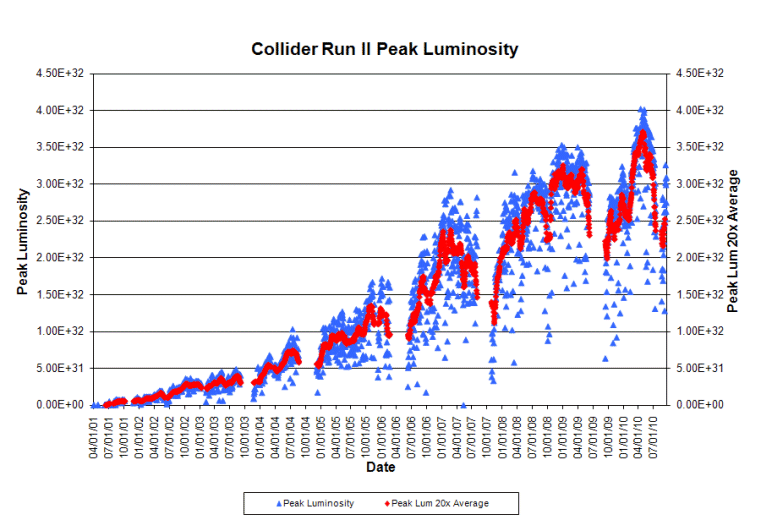No surprise. Yet it feels good to know that in 13 hours over one inverse picobarn of collision data (1.06/pb, to be precise) was delivered to the experiments. We can already make a couple of comparisons with the competing Tevatron collider at this stage.
First of all, the 3.5E31 peak luminosity has been reached in six months from the start of 7 TeV operations. At startup it took the Tevatron two years (2001-2003) to reach the same goal, as you can observe in the graph below.

Still, you might argue that the title of my post is over-enthusiastic: the peak instantaneous luminosity of the Tevatron is ten times larger these days, as the rightmost blue points in the same graph clearly show. So surely, the Tevatron is still the more powerful particle producer, right ?
Wrong. Let me explain why. I argue that what matters to assess the power of an accelerator is really the rate
 of production of rare particles, since that is what these machines are built for: and this depends not only on the instantaneous luminosity
of production of rare particles, since that is what these machines are built for: and this depends not only on the instantaneous luminosity  , but on the cross section for particle production
, but on the cross section for particle production  , as dictated by the master formula
, as dictated by the master formula
Now the formula immediately shows that for the record Tevatron luminosity of 4E32 the rate of production of top-antitop events, which in 1.96-TeV proton-antiproton collisions have a cross section of 7.5 picobarns, is
N = 4E32 x 7.5E-36 = 3E-3 Hz
which means about ten top-antitop pairs per hour. At the LHC, with a luminosity of 3.5E31 and a top-antitop cross section of about 160 picobarns, we get instead
N = 3.5E31 x 160E-36 = 5.6E-3 Hz:
almost twice as many top quark pairs!
And what about the Higgs boson ? Well, for the Higgs we have the luxury of not needing to flip through hep-ph preprints to get the numbers we want: we may use the great Higgs Cross Section Online Calculator, courtesy Massimiliano Grazzini. With some (to some extent arbitrary) choices for a few of the parameters to be given in input, we get that at 7 TeV proton-proton collisions the NNLO production cross section for a 120 GeV Higgs boson is 14.8 pb. At 2 TeV proton-antiproton collisions, the same calculator predicts that for a 120 GeV Higgs boson the NNLO cross section is 0.91 pb. We therefore get:
Record Tevatron Higgs rate: N = 4E32 x 0.91E-36 = 3.6E-4 Hz
Record LHC Higgs rate: N = 3.5E31 x 14.8 E-36 = 5.2E-4 Hz
So also more Higgs bosons are produced per second at the LHC. The LHC has therefore surpassed the Tevatron in rare particle production rates!
Ok, this makes my point clear. However, it is also clear that we should expect more records in the forthcoming weeks: the LHC is circulating 104 proton bunches now, but its maximum capacity is 2808 bunches, which will increase its instantaneous luminosity by over two orders of magnitude. To achieve that goal will take some time, though.
[This article is also available in Greek here]



Comments